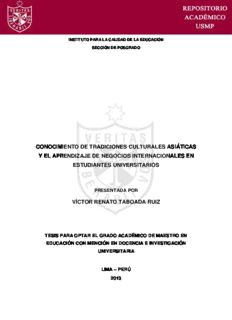
conocimiento de tradiciones culturales asiáticas y el aprendizaje de negocios internacionales en PDF
Preview conocimiento de tradiciones culturales asiáticas y el aprendizaje de negocios internacionales en
INSTITUTO PARA LA CALIDAD DE LA EDUCACIÓN SECCIÓN DE POSGRADO CONOCIMIENTO DE TRADICIONES CULTURALES ASIÁTICAS Y EL APRENDIZAJE DE NEGOCIOS INTERNACIONALES EN ESTUDIANTES UNIVERSITARIOS PRESENTADA POR VÍCTOR RENATO TABOADA RUIZ TESIS PARA OPTAR EL GRADO ACADÉMICO DE MAESTRO EN EDUCACIÓN CON MENCIÓN EN DOCENCIA E INVESTIGACIÓN UNIVERSITARIA LIMA – PERÚ 2013 Reconocimiento - No comercial - Sin obra derivada CC BY-NC-ND El autor sólo permite que se pueda descargar esta obra y compartirla con otras personas, siempre que se reconozca su autoría, pero no se puede cambiar de ninguna manera ni se puede utilizar comercialmente. http://creativecommons.org/licenses/by-nc-nd/4.0/ INSTITUTO PARA LA CALIDAD DE LA EDUCACIÓN SECCIÓN DE POSGRADO CONOCIMIENTO DE TRADICIONES CULTURALES ASIÁTICAS Y EL APRENDIZAJE DE NEGOCIOS INTERNACIONALES EN ESTUDIANTES UNIVERSITARIOS TESIS PARA OPTAR EL GRADO ACADÉMICO DE MAESTRO EN EDUCACIÓN CON MENCIÓN EN DOCENCIA E INVESTIGACIÓN UNIVERSITARIA PRESENTADA POR VICTOR RENATO TABOADA RUIZ LIMA, PERÚ 2013 1 TÍTULO CONOCIMIENTO DE TRADICIONES CULTURALES ASIÁTICAS Y EL APRENDIZAJE DE NEGOCIOS INTERNACIONALES EN ESTUDIANTES UNIVERSITARIOS ii ASESOR Y MIEMBROS DEL JURADO ASESOR: Dr. Oscar Rubén Silva Neyra PRESIDENTE DEL JURADO: Dr. Florentino Mayurí Molina MIEMBROS DEL JURADO: Dra. Alejandra Dulvina Romero Díaz Dr. Víctor Zenón Cumpa González Dr. Raúl Reátegui Ramírez iii DEDICATORIA Detrás del trabajo de cada hombre existe siempre la presencia de una mujer. Dedico este trabajo a las dos mujeres que más amo en mi vida mi madre y Emily, más que un pequeño homenaje este trabajo representa el resultado de su presencia. iv ÍNDICE Páginas Portada …………………………………………………………….............................i Título………………………………………………………………..............................ii Asesor y miembros del jurado: ........................................................................... iii Dedicatoria……………………………………………………………………………..iv ÍNDICE………………………. .............................................................................. v RESUMEN……… .............................................................................................. vii ABSTRACT……. ............................................................................................. viii INTRODUCCIÓN ............................................................................................... ix CAPÍTULO I: PLANTEAMIENTO DEL PROBLEMA ........................................ 1 1.1 Descripción de la realidad problemática ....................................................... 1 1.2 Formulación del problema ............................................................................ 6 1.2.1 Problema general .................................................................................................. 6 1.2.2 Problemas específicos ......................................................................................... 6 1.3 Objetivos de la investigación ........................................................................ 7 1.3.1 Objetivo general ..................................................................................................... 7 1.3.2 Objetivos específicos............................................................................................ 7 1.4 Justificación de la investigación ................................................................... 8 1.5 Limitaciones de la investigación ................................................................... 9 1.6 Viabilidad de la investigación ..................................................................... 10 CAPÍTULO II: MARCO TEÓRICO ................................................................... 11 2.1 Antecedentes de la investigación ............................................................... 11 v 2.2 Bases teóricas ............................................................................................ 18 2.3 Definiciones conceptuales .......................................................................... 73 2.4 Formulación de hipótesis ............................................................................ 76 2.4.1 Hipótesis general ............................................................................................... 76 2.4.2 Hipótesis específicas ....................................................................................... 76 2.4.3 Variables .............................................................................................................. 77 CAPÍTULO III: DISEÑO METODOLÓGICO .................................................... 78 3.1 Diseño de la investigación .......................................................................... 78 3.2 Población y muestra ................................................................................... 79 3.3 Operacionalización de variables ................................................................ 80 3.4 Técnicas para la recolección de datos ....................................................... 83 3.5 Técnicas para el procesamiento y análisis de los datos ............................. 83 3.6 Aspectos éticos .......................................................................................... 84 CAPÍTULO IV: RESULTADOS .................................................................... ….85 CAPÍTULO V: DISCUSIÓN, CONCLUSIONES Y RECOMENDACIONES ... 126 5.1 Discusión…… ........................................................................................... 126 5.2 Conclusiones ……………………………………………………………………127 5.3 Recomendaciones .................................................................................... 128 FUENTES DE INFORMACIÓN ...................................................................... 130 Referencias bibliográficas .............................................................................. 130 Referencias hemerográficas ........................................................................... 133 Referencias electrónicas ................................................................................ 133 ANEXOS………… .......................................................................................... 135 Anexo 1. Matriz de consistencia Anexo 2. Instrumentos para la recolección de datos Anexo 3. Constancia emitida por la institución donde se realizó la investigación vi RESUMEN Los seres humanos son el producto de su naturaleza y de su cultura. Aunque comparten una identidad común, se diferencian en la cultura y costumbres. De ahí la creciente importancia para los alumnos que deseen ser algún día empresarios el estudio de las culturas en el mundo de los negocios, como dinamizador u obstáculo en las transacciones internacionales. Los humanos nos esforzamos por lograr una mejor vida, que implica decidir de manera individual cómo vivirla y la posibilidad de corregir cuando lo creamos conveniente. Debemos entender el negociar como un arte, por ende primero es importante conocer nuestra propia cultura y de ahí entender otras, y de ser posible vivirlas, no hacerlo implica molestias y dificultades en el momento del entendimiento sociocultural. vii ABSTRACT Human beings are the product of nature and culture. Though they share a common identity, they differ in culture and customs. Hence the increasing importance for students who wish to be entrepreneurs someday the study of cultures in the world of business, as a catalyst or an obstacle in international transactions. Humans strive for a better life, which involves deciding individually how to live and the ability to correct when we see fit. We understand the business as an art, therefore it is first important to know our own culture and then understand others, and if possible to live them, do not involve discomfort and difficulties at the time of cultural understanding. viii
Description: